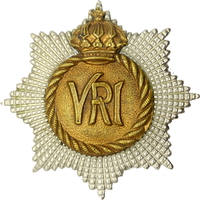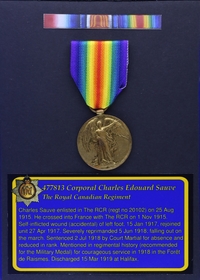
477813 Cpl "Charles Edward" Sauvé
The Royal Canadian Regiment
By: Capt (ret'd) Michael M. O'Leary, CD, The RCR
Charlemagne Edouard Sauvé was born in Montreal, Quebec, on 18 Nov 1894. Sauvé's family can be found in the 1901 Canadian census. Parents Edouard (29) and Donalda (30) are shown with four children; Charlemagne (6), Marie Jeanne (4), Juliette (2), and Germaine (7 months). Before the 19011 Census was taken, both parents would be dead, Edouard in 1906 at the age of 33 and Donalda in 1907 at the age of 36. Charlemagne can be found in the later census at age 16 as a boarder in the home of Lagacé Damase.
Using the anglicized forenames "Charles Edward," Sauvé enlisted with The Royal Canadian Regiment at Toronto, Ontario, on 14 Oct 1914. At the time of his enlistment, The RCR was in Bermuda serving as the garrison battalion on the island. Sauvé would not join the Regiment in Bermuda. He would, however, be in Halifax before the Regiment returned in August of 1915.
Sauvé attested for overseas service in the Canadian Expeditionary Force (C.E.F.) with The RCR at Halifax, N.S., on 23 Aug 1915. A 20-year-old telephone lineman, Sauvé was described on his attestation paper as 5 feet 11 inches tall, weighing 150 pounds, with a 37-inch chest, a medium complexion, light blue eyes, and dark brown hair. His religious denomination was Roman Catholic. Sauvé identified his sister, Marie Jeanne Sauvé, Convent of Holy Family [The Little Sisters of the Holy Family], Sherbrooke, as his next of kin.
The Royal Canadian Regiment had sailed for Bermuda on 11 Sep 1914 to serve for a year on garrison duty. Having relieved the 2nd Battalion, Lincolnshire Regiment, The RCR was replaced in turn by the 38th Overseas Battalion from Canada. The Regiment returned to Halifax for one week during which the Regiment was re-attested for overseas service. Although The RCR had just spent a year in Bermuda, there were concerns regarding the applicability of the soldiers' Permanent Force enlistments for wartime deployments. This was, perhaps, prompted by the idea that a man on a P.F. three-year engagement could choose not to re-engage and the Government would be obligated to bring him home. Enlistment in the C.E.F., on the other hand, was for the "Duration of War." Accordingly, the soldiers of The RCR were re-attested, signing C.E.F. attestation papers in August 1915 before sailing for Europe. It was at this time that some soldiers waiting at the regimental depot in Halifax joined the unit. On 26 Aug 1915, The RCR sailed from Halifax aboard the S.S. Caledonian, the same ship that had brought them home from Bermuda. Disembarked at Plymouth, England, on 6 Sep 1915, the Regiment went to Shorncliffe for training.
On 28 Sep 1915, Sauvé would receive a new C.E.F. service number to replace the regimental number he was assigned on enlisting. While serving in the C.E.F., his service number would be 477813. Since the Regiment received its C.E.F. numbers while at full strength and not as they were recruited, it had the interesting effect that the soldiers of the Regiment at the time were renumbered in alphabetical order.
Sauvé completed a military Form of Will on 13 Oct 1915. In this will, in the event of his death, he bequeathed the whole of his estate to his three sisters; Jeanna, Juliette, and Germaine, all of Rigaud, P.Q. The Form of Will is one of the few documents on which his proper name was used; Charlemagne Edouard Sauvé.
The RCR crossed the English Channel on 1 Nov 1915, entering the theatre of war at Boulogne, France. During November and December of 1915 the Regiment prepared for service in the trenches, with companies rotating in the lines for training and a period of providing working parties before entering the line as a battalion at the end of December. The first months of 1916 saw the Regiment in the steady rotation through front line trenches, support trenches, and reserve positions that was the fundamental experience of the infantry in the Great War.
Sauvé's service with the Regiment throughout 1916 was interrupted by two episodes of illness and brief hospitalizations. On 12 Apr 1916, he was admitted to No. 7 General Hospital at St. Omer with German measles. He remained in hospital until 23 Apr 1916 when he was discharged and returned to duty with the Regiment the following day.
In the fall, on 2 Oct 1916, Sauvé was again hospitalized, being admitted to No. 3 General Hospital with influenza. He was discharged from hospital to Base Details on 13 Oct 1916 and remained there until 27 Oct 1916 when he left the Canadian Base Depot for the 3rd Entrenching Battalion. This Divisional troops unit was employed as a ready labour force and by design its troops were a forward reserve of reinforcements for the division's fighting battalions. They were also used as labour forces to maintain and build trenches or other work as needed. Sauvé would only spend three days with the Entrenching Battalion before rejoining The RCR on 30 Oct 1916.
Sauvé was back in hospital in early 1917. On 15 Jan 1917, he was admitted to No. 32 Casualty Clearing Station (C.C.S.) with a gun shot wound of the left foot. It was recorded that this injury, albeit accidental, was self-inflicted. This resulted in Sauvé' admission to the 32 C.C.S. Special Hospital, probably while his case of self-inflicted wounding was investigated to determine if disciplinary action was necessary. There is no evidence in his service record of disciplinary action, so it can be assumed that the report of his injury's accidental nature was accepted.
On 10 Apr 1917, Sauvé was transferred to No. 8 Stationary Hospital at Wimereux. Three days later, on 13 Apr 1917, he was discharged from hospital. Sauvé was transferred to the Canadian Base Depot (C.B.D.) on 20 Apr 1917. He left the Depot to rejoin The RCR in the field the next day, reaching the Regiment on 27 Apr 1917 after another brief medical episode. Between 23 and 25 Apr 1917, he had been admitted to No. 6 C.C.S. suffering from inflammation of the connective tissues (I.C.T.) of the feet.
Commencing in June 1917 and until the end of that year, Sauvé maintained a monthly pay assignment of $15. This assignment was forwarded to his sister, Mrs. L.J. Lamarche in Montreal, P.Q. As a Private in the C.E.F., Sauvé was paid $1.00 per day plus an additional ten cents daily field allowance. His pay assignment represented about one-half of his monthly pay.
On 16 Sep 1917, Sauvé was granted 10 days leave to Paris. His leave experiences revisited him on 29 Sep 1917 when he was evacuated form the field, sick, on 29 Sep 1917. After passing through No. 10 Canadian Field Ambulance he was admitted to No. 22 C.C.S. with gonorrhea (V.D.G.). With a diagnosis of venereal disease and the likelihood of extended treatment, Sauvé was transferred from The RCR to the 3rd Canadian Infantry Base Depot (C.I.B.D.). Soldiers were not usually transferred from the strength of their parent unit while hospitalized in France, this normally occurred only if they were evacuated to England. On 3 Oct 1917, Sauvé was transferred to 51 General Hospital, Etaples, with "V.D.S.C., slight" [venereal disease syphilitic chancre].
Sauvé was discharged to duty on 3 Nov 1917. Effective the same date, he was deemed to have forfeited his Field Allowance and placed under stoppage of pay at the rate of 50 cents per diem whilst in hospital from 3 Oct to 3 Nov 1917. This loss of half his pay and his allowances for 31 days while under medical care for V.D. accounted for the period he had made himself unemployable as a soldier due to his self-inflicted illness. For some men itt may have also served as an additional incentive to avoid contracting such diseases.
Sauvé departed the C.I.B.D. for the Canadian Corps Reinforcement Camp (C.C.R.C.) on 12 Nov 1917. He rejoined The RCR in the field on 5 Dec 1917 and was appointed Lance Corporal two days later. Less than two weeks after gaining his first rank stripe, he was promoted Corporal to complete establishment on 14 Dec 1917.
After only a week in his new rank, Sauvé risked losing it. On 22 Dec 1917, he was reprimanded for being absent without leave from 1.15 p.m. on 20 Dec 1917 to 5 p.m. on 22 Dec 1917. He also forfeits three days pay by Royal Warrant in addition to the punishment of a reprimand.
Sauvé behaved himself until the following summer. On 5 Jun 1918 he again fell afoul of the military's disciplinary system when he was severely reprimanded. This time his crime was falling out of the line of march without permission and failing to return. Despite his transgressions, the unit leadership saw potential in Sauvé. On 16 Jun 1918, he was sent to Le Touquet to attend the Lewis Gun Course.
The Lewis Gun Course conducted at the G.H.Q. Lewis Gun and Trench Mortar School was supposed to last three weeks. Unfortunately, Sauvé didn't last that long at the school. On 25 Jun 1918, he was admitted to 51 General Hospital at Etaples suffering from another bout of venereal disease.
Sauvé chose not to remain in hospital after his admission. He chose instead to absent himself (without leave) at Etaples from 26 until 28 Jun 1918. Arrested on 29 Jun 1918 and tried on 2 Jul 1918 by Field General Court Martial (F.G.C.M.), he was found guilty and sentenced to be Reduced to the Ranks (i.e., reverted back to the rank of Private), thus losing his Corporal's stripes. Sauvé also forfeited 3 days pay by Royal Warrant for the period of his absence.
While Sauvé was treated for venereal disease, he was again affected by the forfeiture of his field allowance and was placed under stoppage of pay at the rate of 50 cents per diem while in hospital from 23 Jun to 24 Sep 1918. This stoppage of 94 days pay and allowances amounted to $56.40, a hefty sum for a soldier paid $1.10 per day (including field allowance).
Sauvé was discharged from hospital to duty 27 Sep 1918. Three days later, on 30 Sep 1918, he was again appointed Lance Corporal. Moving from the C.I.B.D. to the C.C.R.C. on 2 Oct 1918, Sauvé rejoined The RCR in the field on 5 Oct 1918. Within a week, he was promoted back to the rank of Corporal.
Near the end of the war, a recommendation for the award of the Military Medal to Sauvé was prepared by The Royal Canadian Regiment. Although the recommendation was not among those which successfully resulted in the award, a copy of the recommendation form survives in the archives of the Regiment today. The citation reads:
"477813 Lance Corporal Charles Edward Sauvé
"For gallantry and devotion to duty in operation on FRESNES, this NCO displayed great gallantry in leading his section when the right flank was held up by heavy M.G. fire, he quickly appreciated the position and lead his section around the enemy's flank under heavy M.G. fire forcing them to retire, thus enabling his company to advance. This N.C.O's disregard for his personal safety and devotion to duty has been an inspiration to all ranks."
Sauvé is also mentioned in the regimental history, The Royal Canadian Regiment, 1883-1933, by R.C. Fetherstonhaugh (pub. 1933) records:
"Marching out from Cataine in battle order on the morning of October 22 [1918], The Royal Canadian Regiment took over the front as ordered and, with "C" Coy. on the right, "D" Coy. on the left, and "A" and "B" Companies in support, pushed forward through the Foret de Raismes. It was raining heavily, the under-brush in places was thick, and the deep ditches provided exasperating obstacles for troops in battle order, nevertheless the advance progressed quite satisfactorily. It was almost unopposed, but there were occasional skirmishes with rear-guards of the enemy. Few casualties resulted from these, but the day's list included the name of Capt. A. MacDonald, who was wounded. In brushes with lurking enemy parties, Lance-Corporal C. E. Sauve and Lance-Corporal G. Timms rendered courageous service." (p. 369)
With the war over and the Regiment still waiting to return to Canada in the first months of 1919, Sauvé was granted 10 days Special Leave in France on 4 Jan 1919. He rejoined the Regiment on 22 Jan 1919.
In the first stages of the homeward journey, Sauvé proceeded to England on 6 Feb 1919. Soon after, on 9 Feb 1919, he was medically examined at Bramshott in preparation for his return to Canada and discharge. The examination form noted his occurrences of measles, shot wound, I.C.T., influenza, and V.D., but noted he was recovered from all of these and had no permanent disabilities.
Charles Edward Sauvé was struck off the strength of The RCR and the Overseas Military Forces of Canada with effect from 1 Mar 1919 on proceeding to Canada. He returned aboard the S.S. Adriatic.
Sauvé was discharged from the C.E.F. at Halifax, N.S., on 15 Mar 1919. His discharge certificate noted that he had received the Class "A" War Service Badge, numbered 233536. The form also noted that he had gotten a tattoo during his service, of a sword and snake on his right forearm. One of Sauvé' discharge forms noted that his intended place of residence after the war was "Assiniboia, Saskatchewan." This was later amended to c/o Mrs. L.J. Lamarche, 202a Letouneut Ave., Maisonneuve, Montreal, P.Q.
Sauvé was eligible to receive a War Service Gratuity of $420. This gratuity was paid to him in monthly installments between March and August 1919. For his service in the C.E.F., Sauvé was entitled to receive the 1914-15 Star, the British War Medal, and the Victory Medal. These were despatched to him c/o Mrs. L.J. Lamarche, 202a Letouneut Ave., Maisonneuve, Montreal, P.Q., in 1921.
On 2 May 1922, Charlemagne Sauvé married Elsie Gilbert. The ceremony took place in the St. Joachim Parish, Point-Claire, in the Montreal diocese.
The Sauvés appear in the census data for the United States in 1940. At the time, Charles and Elsie are living at 830 Stanyan St., San Francisco, California. Sauvé is shown as working as a wage or salary worker in private work in an electrical field or trade, although he had only worked for 16 weeks in 1939. His reported annual income was $550.
Charlemagne "Charles" Sauvé died at San Francisco, California, on 15 Feb 1945. He is buried in the Holy Cross Catholic Cemetery in Colma, San Mateo County, Calif. Elsie Sauvé survived her husband for almost four decades and died at Pacifica, San Mateo, Calif., on 27 Jan 1983.
Pro Patria
Visit a randomly selected page in The O'Leary Collection (or reload for another choice):
- The O'Leary Collection; Medals of The Royal Canadian Regiment.
- Researching Canadian Soldiers of the First World War
- Researching The Royal Canadian Regiment
- The RCR in the First World War
- Badges of The RCR
- The Senior Subaltern
- The Minute Book (blog)
- Rogue Papers
- Tactical Primers
- The Regimental Library
- Battle Honours
- Perpetuation of the CEF
- A Miscellany
- Quotes
- The Frontenac Times
- Site Map
QUICK LINKS
The O'Leary Collection—Medals of The Royal Canadian Regiment
Newest additions:
![]()
![]() SB-12725 Private Henry "Hank" Ard
SB-12725 Private Henry "Hank" Ard ![]()
WIA at Hill 187, Died of Wounds in Japan
![]()
![]() 2355331 Lance Corporal Albert Lorking
2355331 Lance Corporal Albert Lorking
Wounded in action, later a War Amps representative.
![]()
![]() 4334 / 477996 Pte Isaac Hamilton Wilcox
4334 / 477996 Pte Isaac Hamilton Wilcox
Permanent Force, South Africa, and C.E.F.
![]()
![]() 477019 Private Harold Ashcroft
477019 Private Harold Ashcroft
Transferred to the Tunnelers.
![]()
![]() 734231 Private Clark D. Thompson
734231 Private Clark D. Thompson ![]()
The older Thompson brother, killed in action.
![]()
![]() 733849 Private Norman Parker Thompson
733849 Private Norman Parker Thompson
The younger Thompson brother; post-war service in the Special Guard.
![]()
![]()
![]() A305 / 400305 Private Andrew Walker
A305 / 400305 Private Andrew Walker ![]()
"Previously reported Wounded, now Killed in Action."
![]()
![]() 823298 Pte Thomas Patrick Steele, M.M.
823298 Pte Thomas Patrick Steele, M.M. ![]()
… for gallant conduct in the field …
![]()
![]() P13066 Sergeant Harold Thompson
P13066 Sergeant Harold Thompson
Instrumental Soloist for over 20 years of Canadian Army service.
![]()
![]() 9609 / 477728 Private Albert Edward Piper
9609 / 477728 Private Albert Edward Piper
"Arrived from England as a STOWAWAY …"



